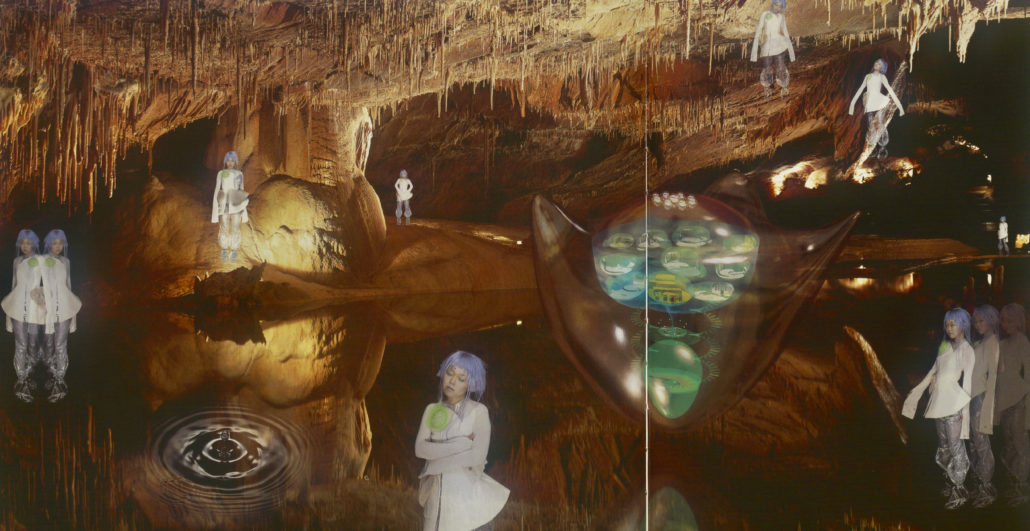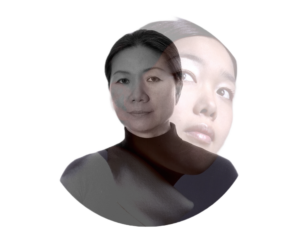
Mirror of Water
The third image in the series, “Mirror of Water,” (Fig.15) was photographed in the Grotte de Cussac, a French cave in Dordogne, famous for containing over 150 Paleolithic artworks as well as several human remains. The cave, sculpted by water over millions of years, was likely chosen by Mori because of its spiritual and sacral importance. The cave is one of the oldest examples of a global spiritualty, according to archeological groups, representing relocation and identity after death.[72] In “Mirror of Water,” Mori combines the traditional and the futuristic, as in “Entropy of Love.” We see this combination of the traditional and the futuristic again in Mori’s artwork titled “Pratibimba III” from 1998 (Fig. 16). The “Pratibimba” series is a series of three that represents the past, present, and future. Mori dresses up as each of the three members of the “Pratibimba” triptych.[73] She repeats this exact self-portrait in “Mirror of Water,” similar to how she does in “Burning Desire,” but in a more obvious way. Her repeated self-portrait suggests that the self is “part of a continuous chain of life, death, dissolution, and rebirth.”[74] Carol S. Eliel writes that “human consciousness follows the endless cycle from the eternal past to the eternal future,” similar to how the cave endlessly changes in shape from the water constantly flowing through it.[75] Unlike “Burning Desire,” the repeated self-portrait characters in “Mirror of Water” are nearly identical, almost as if they were copied and pasted to different corners of the collage. However, they are meant to be Mori at eight different moments, all somewhere in that endless cycle. The eight moments or stages of life are infancy, toddlerhood, preschool years, early school years, adolescence, young adulthood, middle adulthood, and late adulthood.[76] However, because Mori looks the same age in each moment despite changing positions, the eight moments are meant to represent the steps in the eightfold path to nirvana. Briefly defined, the steps of the path are right understanding, right thought, right speech, right action, right livelihood, right effort, right mindfulness, and right concentration. Although these figures cannot specifically be paired to each of the eight steps, “Mirror of Water” conveys the idea of continuity Mori’s body floats upwards in a couple instances and has translucent, balloon legs, as if she’ll float out of the frame in just a few moments. The elements of transparency in Mori’s legs, the effect that would have on her ability to stabilize or root herself, and the reflection of the water are important visual effects in this image that can indicate feminist ideology, inward reflection, and Mori’s place in society.

Moving on from Mori’s figure in Mirror of Water, we must look at the other visual elements that make up the image. In the middle of the dark cave, we see the object Mori calls the “UFO,” which houses a variety of rooms. The form recalls the womb-like bubble in “Entropy of Love” with its multiple egg-shaped capsules. Within the bubble (Fig. 17), ten different rooms make up the space, one of which is the “tea ceremony room of the future,” another combination of the traditional with the futuristic.[77] The room in yellow at the bottom of the bubble is not unlike the room we see Mori serving tea to a group of men in an earlier piece called “Tea Ceremony I” (Fig. 18) from her Tea Ceremony series. Finally, it is worth noting that, at the top of the bubble, we see a group of white spheres, nearly identical to her father’s “sunflower” invention mentioned previously (Fig. 2). Where the ideas of Buddhism are a bit more abstract and less tangible, the soft feminist ideologies can be found straightforward with the right facts. Unlike Burning Desire, which is full of spiritual iconography and fewer feminist elements, Mirror of Water is the opposite. Mori reuses cyborg and feminist imagery that we see in previous works that are straightforwardly commenting on a women’s role in society.


